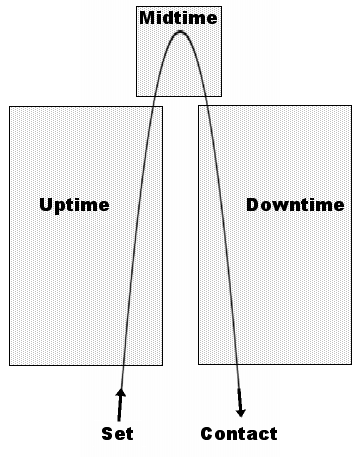Parabolic motion is a term that describes the motion of the footbag through the air. Often the bag is described only as moving up and down, which is just for the sake of simplicity.

Parabolic motion with uptime, midtime, and downtime components illustrated.
Parabolic motion as applied to footbag freestyle is essentially simply the natural gravitational effect of setting the footbag up with a certain amount of force and at a certain angle (which affects the width of the parabola) which determines the height and ultimate landing place of the footbag. (See [1] for more information on parabolas in general.)Not only does the bag move towards, away, to the left, and to right (perspectively) of the player, the player will often set the bag into a parabolic motion that allows him/her to hit the trick more easily.
Parabolic motion can be easily noticed in consecutive far butterflies, which are also called infinities, because the motion of the bag is in that of an infinity symbol.
It is important to note that the vast majority of top players try their hardest to set the bag exactly straight up and down, with no sideways motion at all (thus, an imperceptibly narrow parabola). 5-time world champion Vasek Klouda is a fantastic example of not setting the footbag sideways. Some players view wider parabolic sets as “sloppy” or “unclean”.
Either way, the parabolic motion (however narrow the parabola) is the foundation of freestyle move analysis as we define move components using the basic chart on the right.
